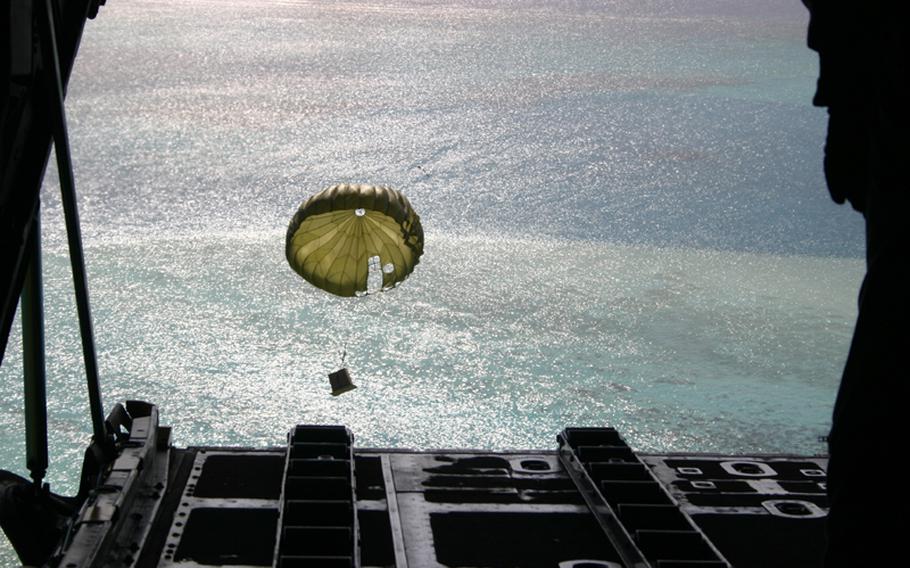
A box full of gifts and supplies makes its way to the water off Elato Island in Yap State in the Federated States of Micronesia. The box was parachuted as part of the 2005 Christmas Drop out of Andersen Air Force Base, Guam, from a C-130 transport plane crewed by members of the 36th Airlift Squadron of the 374th Airlift Wing based in Yokota Air Base, Japan. Boats are positioned below to retrieve the box. (Frank Whitman/Special to Stars a)
YOKOTA AIR BASE, Japan — U.S. C-130s roar through the skies above Micronesia each December to the delight of residents of the hundreds of tiny islands that form the remote nation in the western Pacific.
The islanders know “Operation Christmas Drop” always delivers the goods.
Crew members communicate with the islanders through the help of volunteer radio operators from the University of Guam before releasing the bundles of food, supplies and toys (of course) from their cargo doors.
“You can hear the excitement and anticipation on the other end of the radio when we come in,” said Col. Mark Hering, 374th Operations Group commander at Yokota, whose pilots on Monday will begin the 59th annual humanitarian mission – the longest running in U.S. Air Force history.
Nearly 100 pilots, loadmasters and other airmen from Yokota will deliver the gifts, which are collected through donation drives on Guam. The Yokota team then picks up the cargo at Guam’s Andersen Air Force Base and literally drops it off to the islands.
The people of the Federated States of Micronesia – a country with limited resources where nearly one-quarter of the population lives below the poverty line – “use every piece of equipment we drop,” Hering said. “Even the parachutes.”
But for the children of Micronesia, the fishing gear, over-the-counter medicines and other valuable basic provisions take a backseat to the toys, which are thought to come from Santa himself.
The Christmas drop started in 1952 when the aircrew of a WB-29 bomber from Anderson flew over the Micronesian atoll of Kapingamarangi and noticed the islanders waving to them. The crew quickly gathered some items they had on the plane, placed them in a container with a parachute attached and dropped the cargo as they circled back over, according to the Air Force.
The operation and its Christmas connection charmed a Japanese rotary affiliated with Yokota so much that the club commissioned an illustrated children’s book to commemorate the story. “Christmas Drop Angels in Micronesia” is on sale at various locations on Yokota for $10 or 1,000 yen to help raise money for Operation Christmas Drop.
The Tachikawa Kobush Rotary Club already donated the $25,000 it hopes to raise from the book’s sale to the Air Force, which invested the money in new parachutes for this year’s runs. Air crews will drop 60 bundles – each carrying up to 500 pounds of goods – throughout the five-day mission.
The military planes “brought the gifts from Santa,” Micronesian Melner Isaac wrote in the book’s afterward. He grew up on the island of Pingelap when there was still no electricity and its “king” doled out the gifts that fell from the sky every December. A speech Isaac gave on his childhood experience with the Christmas drops during a rotary conference last year inspired his counterparts from Japan to act.
The Tachikawa Kobush Rotary Club hopes the book will also promote the program, which is known to few outside of Micronesia and the U.S. military community in the Pacific.
“Our members were deeply moved,” said Shigeru Suzuki, the club’s president, who compared the story behind the mission to the venerable “Yes, Virginia, there is a Santa Claus” editorial that ran in the New York Sun in 1897.
“Everyone has a Christmas dream of Santa,” Suzuki said.
This story has been corrected from its original version.